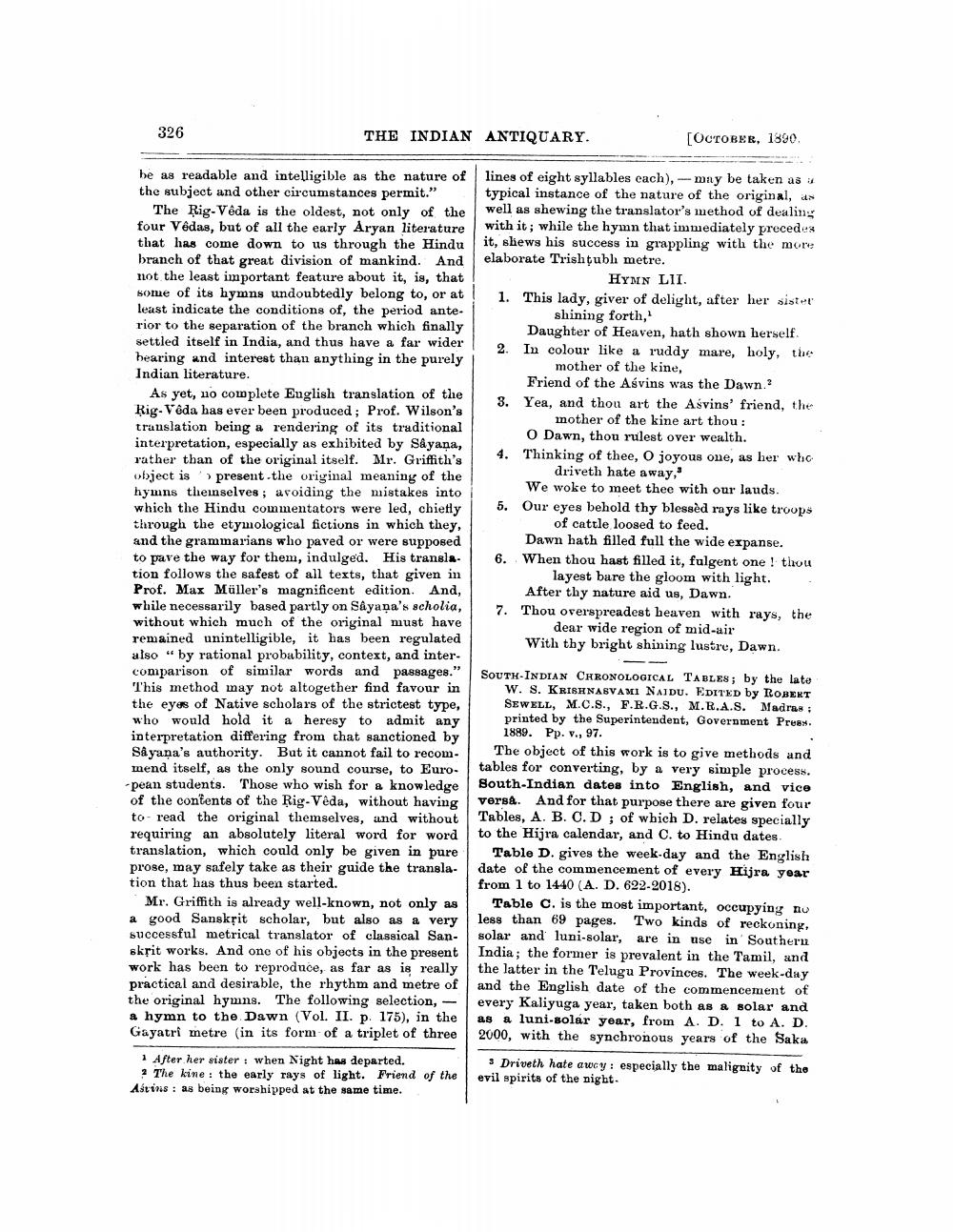________________
326
THE INDIAN ANTIQUARY.
[OCTOBER, 1890
te.
be as readable and intelligible as the nature of the subject and other circumstances permit."
The Rig Veda is the oldest, not only of the four Vedas, but of all the early Aryan literature that has come down to us through the Hindu branch of that great division of mankind. And not the least important feature about it, is, that some of its hymns undoubtedly belong to, or at least indicate the conditions of, the period ante. rior to the separation of the branch which finally settled itself in India, and thus have a far wider hearing and interest than anything in the purely Indian literature.
As yet, no complete English translation of the Rig. Voda has ever been produced ; Prof. Wilson's translation being a rendering of its traditional interpretation, especially as exhibited by Sayana, rather than of the original itself. Mr. Griffith's object is present the original meaning of the hymns themselves; avoiding the mistakes into which the Hindu commentators were led, chietly through the etymological fictions in which they, and the grammarians who paved or were supposed to pave the way for them, indulged. His translation follows the safest of all texts, that given in Prof. Max Müller's magnificent edition. And, while necessarily based partly on Sâyana's scholia, without which much of the original must have remained unintelligible, it has been regulated also " by rational probability, context, and intercomparison of similar words and passages." This method may not altogether find favour in the eyes of Native scholars of the strictest type, who would hold it a heresy to admit any interpretation differing from that sanctioned by Sayana's authority. But it cannot fail to recommend itself, as the only sound course, to Euro. -pean students. Those who wish for a knowledge of the contents of the Rig Veda, without having to read the original themselves, and without requiring an absolutely literal word for word translation, which could only be given in pure prose, may safely take as their guide the translation that has thus been started.
Mr. Griffith is already well-known, not only as a good Sanskrit scholar, but also as a very successful metrical translator of classical Sanskrit works. And one of his objects in the present work has been to reproduce, as far as is really practical and desirable, the rhythm and metre of the original hymns. The following selection, a hymn to the Dawn (Vol. II. p. 175), in the Gayatri metre (in its form of a triplet of three
After her sister when Night hos departed. 2 The kine : the early rays of light. Friend of the Aštinis: as being worshipped at the same time.
lines of eight syllables cach), -mny be taken as typical instance of the nature of the original, as well as shewing the translator's method of dealin with it; while the hymn that immediately precedes it, shews his success in grappling with the more elaborate Trishţubl metre.
HYMN LII. 1. This lady, giver of delight, after her sister
shining forth, Daughter of Heaven, hath shown herself 2. In colour like a ruddy mare, holy, the
mother of the kine, Friend of the Asvins was the Dawn.? 3. Yea, and thou art the Asvins' friend, the
mother of the kine art thou : O Dawn, thou rulest over wealth. 4. Thinking of thee, O joyous one, as her who
driveth hate away, We woke to meet thee with our lauds. 5. Our eyes behold thy blessed rays like troops
of cattle loosed to feed. Dawn hath filled full the wide expanse. 6. When thou hast filled it, fulgent one ! thou
layest bare the gloom with light. After thy nature aid us, Dawn. 7. Thou overspreadest heaven with rays, the
dear wide region of mid-air With thy bright shining lustre, Dawn.
SOUTH INDIAN CHRONOLOGICAL TABLES; by the late
W. S. KRISHNASVAMI NAJDU. EDITED by ROBERT SEWELL, M.C.S., F.R.G.S., M.R.A.S. Madras : printed by the Superintendent, Government Press. 1889. Pp. v., 97.
The object of this work is to give methods and tables for converting, by a very simple process. South-Indian dates into English, and vice versa. And for that purpose there are given four Tables, A. B. C.D; of which D. relates specially to the Hijra calendar, and C. to Hindu dates
Table D gives the week-day and the English date of the commencement of every Hijra yoar from 1 to 1440 (A. D. 622-2018).
Table C. is the most important, occupying nu less than 69 pages. Two kinds of reckoning, solar and luni-solar, are in use in Southern India; the former is prevalent in the Tamil, and the latter in the Telugu Provinces. The week-day and the English date of the commencement of every Kaliyuga year, taken both as a solar and as a luni.solár year, from A. D. 1 to A. D. 2000, with the synchronous years of the Saka
3 Driveth hate arcy: especially the malignity of the evil spirits of the night.




